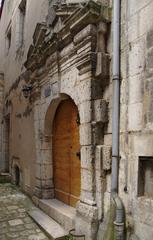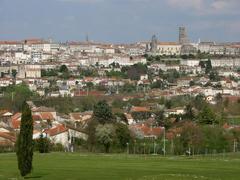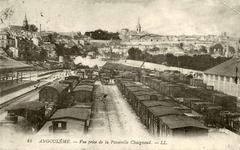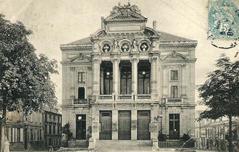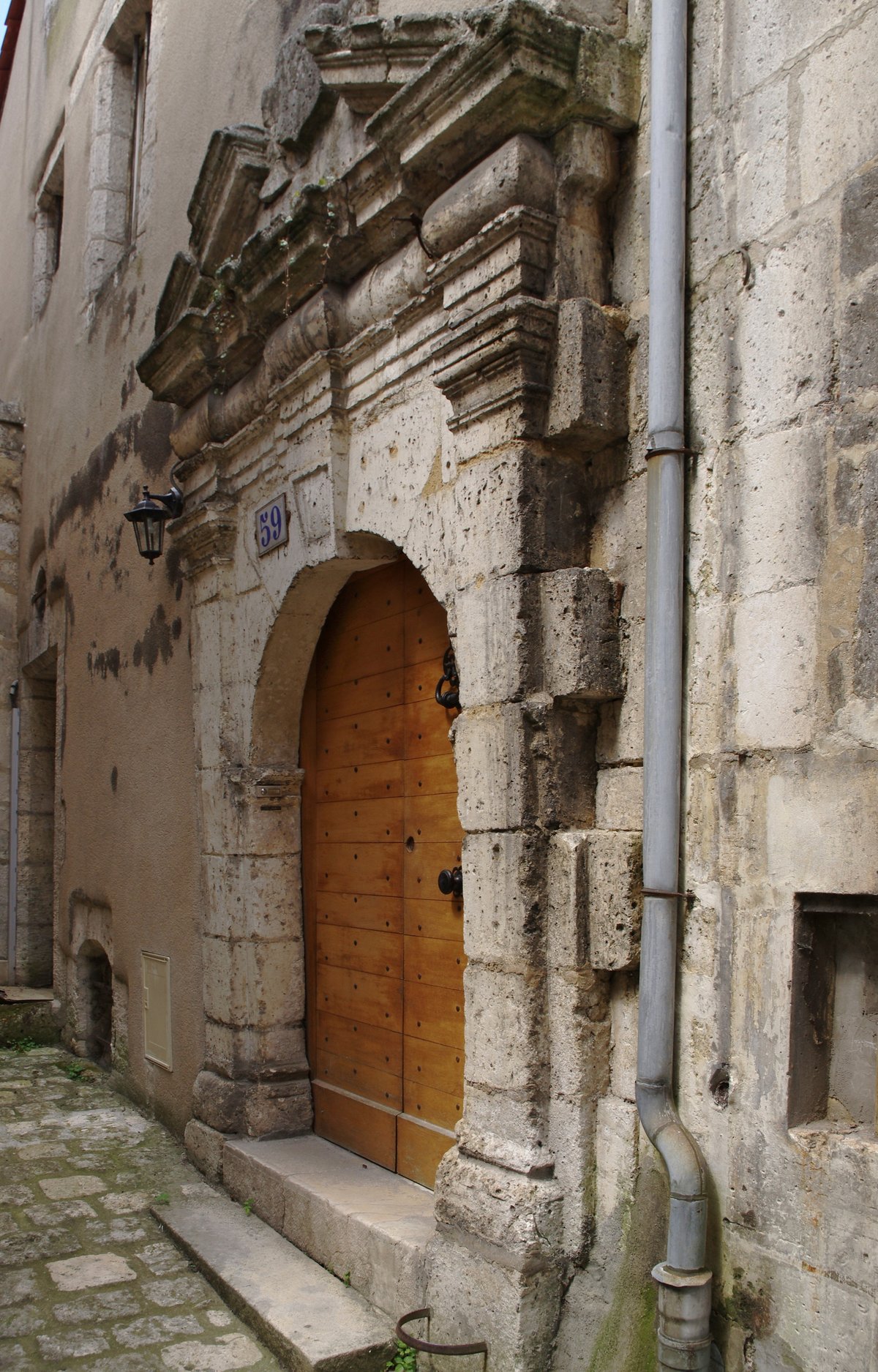
Old Door Porte Ancienne Angoulême: Comprehensive Guide to Visiting Hours, Tickets, and Historical Sites
Date: 14/06/2025
Introduction: Unveiling the Old Door’s Historical Significance
Nestled in the heart of Angoulême’s historic center, the Old Door at 59 Rue du Minage stands as a remarkable testament to the city’s rich medieval and Renaissance heritage. Once the gateway to bustling grain and fish markets, this architectural relic offers visitors an authentic window onto centuries of urban, commercial, and cultural evolution. Overlooking the Charente River from its rocky promontory, Angoulême’s strategic location has shaped its development since antiquity, with its layered defenses and vibrant street network echoing through the present day (France-Voyage).
The Old Door, emblematic of the Minage quarter’s mercantile legacy, bridges Angoulême’s storied past with its dynamic present. This guide delivers all you need to make the most of your visit—covering practical details on visiting hours and accessibility, the history and architectural features of the site, as well as recommendations for nearby attractions and experiences.
Table of Contents
- Historical Context: The Minage Quarter and Angoulême’s Urban Fabric
- Architectural and Cultural Significance
- Visiting Information: Hours, Tickets & Accessibility
- Travel Tips and Nearby Attractions
- Preservation and Contemporary Relevance
- Frequently Asked Questions (FAQ)
- Conclusion & Call to Action
- Sources and Further Reading
1. Historical Context: The Minage Quarter and Angoulême’s Urban Fabric
The Old Door sits within the Minage quarter, one of Angoulême’s oldest areas, whose name and identity are rooted in the grain trade that flourished here from the medieval era through the 19th century (Le Guide Pratique). “Minage” alludes to the weighing and trading of cereals—a pivotal economic activity that shaped the neighborhood’s layout and energy.
The city’s origins date to the late Roman Empire, when Angoulême first established defensive ramparts. By the 9th century, it had become the seat of the counts of Angoulême (Britannica). The medieval plan of narrow, winding streets—such as Rue du Minage—remains largely intact, offering a tangible link to the city’s formative centuries.
The Place du Minage, once home to vibrant market halls, evolved through cycles of urban renewal—most notably during the 19th century, when covered markets and public squares replaced older structures. Today, a historic fountain featuring cherubs and tritons commemorates the area’s commercial roots (Fontaines de France).
2. Architectural and Cultural Significance
The Old Door at 59 Rue du Minage is more than a picturesque artifact; it’s a tangible link to Angoulême’s mercantile and civic past. Characterized by robust stonework, arched lintels, and aged ironwork, the door likely dates from the 17th to 18th centuries, a period marked by flourishing trade and artisanal activity (Angoulême Heritage). Its limestone façade and intricate details reflect the prosperity of the Minage quarter’s former residents—merchants and craftspersons whose daily lives shaped the city’s rhythms.
Importantly, the Old Door functions not as a museum piece but as a living part of the urban landscape, surrounded by artisan shops, cafés, and galleries. The Minage quarter’s ongoing vitality is evident in its blend of historic charm and contemporary culture, further underscored by Angoulême’s reputation as a “City of Art and History.”
3. Visiting Information: Hours, Tickets & Accessibility
Visiting Hours:
The Old Door is an exterior architectural feature located on a public street and is freely accessible 24/7. For optimal viewing and photography, visit during daylight hours—ideally between 9:00 AM and 6:00 PM.
Tickets:
There is no admission fee or ticket required. The site is open to all as part of Angoulême’s historic public realm.
Accessibility:
The Minage quarter’s pedestrian-friendly layout makes it ideal for exploration on foot. However, some cobblestone streets and occasional steps may pose challenges for those with limited mobility. The nearest public parking facilities are “Parking Hôtel de Ville” and “Parking Les Halles,” both within a 10-minute walk. Consult the Angoulême public transport network for bus routes; the “Hôtel de Ville” stop is closest.
Guided Tours:
The Angoulême Tourist Office offers thematic walking tours (in French and English) that include the Old Door and other highlights of the historic center (Angoulême Tourisme). Booking is recommended, especially during peak seasons and festivals.
4. Travel Tips and Nearby Attractions
-
Photography: Early morning and late afternoon light best reveal the textures and colors of the Old Door and its surroundings. Tripods are generally permitted; be mindful of pedestrian flow.
-
Cafés & Local Shops: Enjoy Charentais bread, goat cheese, and regional specialties in the quarter’s cafés and bakeries.
-
Nearby Attractions:
- Cathedral of Saint-Pierre: A Romanesque masterpiece within walking distance.
- Place du Minage: The historical grain market square with its iconic fountain.
- Rue Vauban and Rue des Cordonnier: Streets lined with historic mansions and artisanal shops.
- International Comics Festival: Held each January, bringing vibrant energy and art to the old town (Angoulême Comics Festival).
- Covered Market Les Halles: For local produce and delicacies.
-
Accessibility Note: The upper town’s cobbled streets may be difficult for strollers and wheelchairs. Assistance is available at the tourist office.
5. Preservation and Contemporary Relevance
Angoulême’s recognition as a “Ville d’Art et d’Histoire” reflects its commitment to heritage preservation (French Ministry of Culture). Restoration and conservation projects in the Minage quarter ensure the authenticity of landmarks like the Old Door while supporting the area’s modern vibrancy. The site is also featured during special events such as the European Heritage Days, when private courtyards and historic interiors are occasionally opened to visitors.
Supporting local artisans and engaging with the living history of the quarter contributes to ongoing preservation efforts and enriches the visitor experience.
6. Frequently Asked Questions (FAQ)
Q: Are tickets or reservations required to visit the Old Door?
A: No, the Old Door is freely accessible at all times and does not require tickets or reservations.
Q: What are the best hours for photography?
A: Early morning and late afternoon provide the best natural light and a quieter atmosphere.
Q: Is the site wheelchair accessible?
A: Access may be challenging due to cobbled streets and steps. Contact the tourist office for assistance.
Q: Are guided tours available?
A: Yes, thematic walking tours including the Old Door can be booked via the Angoulême Tourist Office.
Q: What other historical sites are nearby?
A: The Cathedral of Saint-Pierre, Place du Minage, covered market Les Halles, and the city’s painted walls are all within walking distance.
7. Conclusion & Call to Action
The Old Door at 59 Rue du Minage stands as a living symbol of Angoulême’s layered history, offering a direct connection to the city’s medieval and Renaissance past. Its freely accessible location, architectural charm, and integration into the vibrant Minage quarter make it an essential stop for visitors seeking to immerse themselves in Angoulême’s unique heritage.
Enhance your visit by joining a guided tour, exploring nearby monuments, and supporting local businesses. For up-to-date information, maps, and exclusive content—including high-quality images and virtual tours—download the Audiala app and consult official tourism resources.
Plan your journey today and step through the Old Door into the heart of Angoulême’s history and culture.
8. Sources and Further Reading
- Angoulême Tourisme, Official Tourism Office
- Britannica, Angoulême
- France-Voyage, Angoulême Tourism Guide
- Le Guide Pratique, Place du Minage and Angoulême Heritage
- Fontaines de France, Place du Minage Fountain
- Angoulême Heritage
- Angoulême Comics Festival
- French Ministry of Culture
- Angoulême Public Transport
